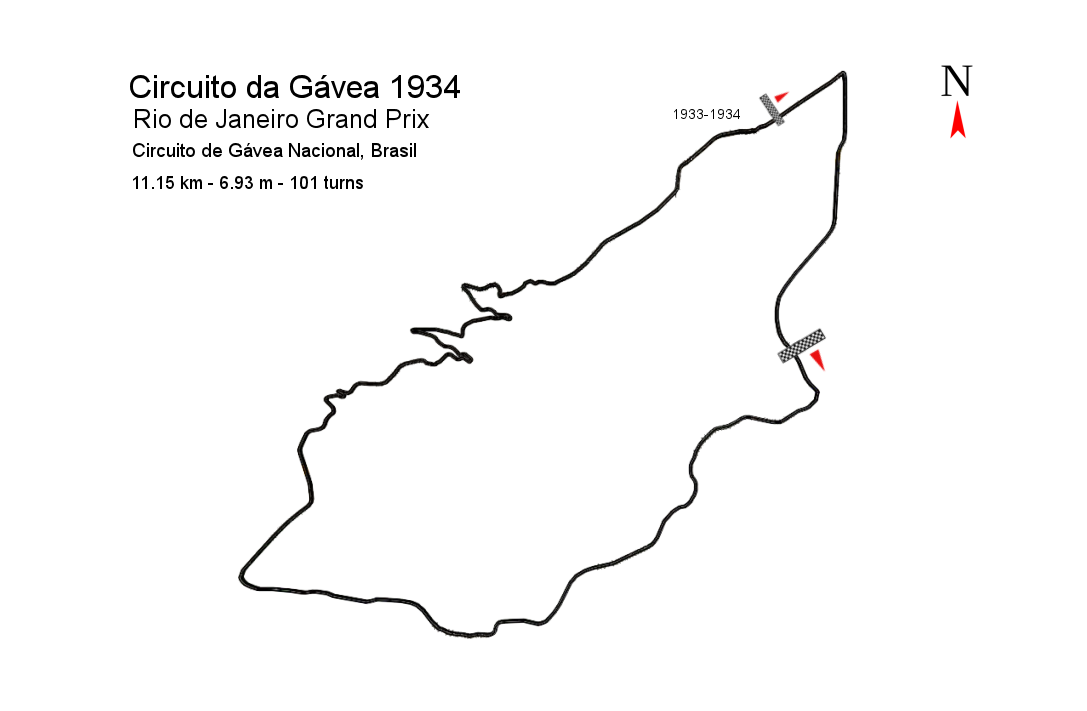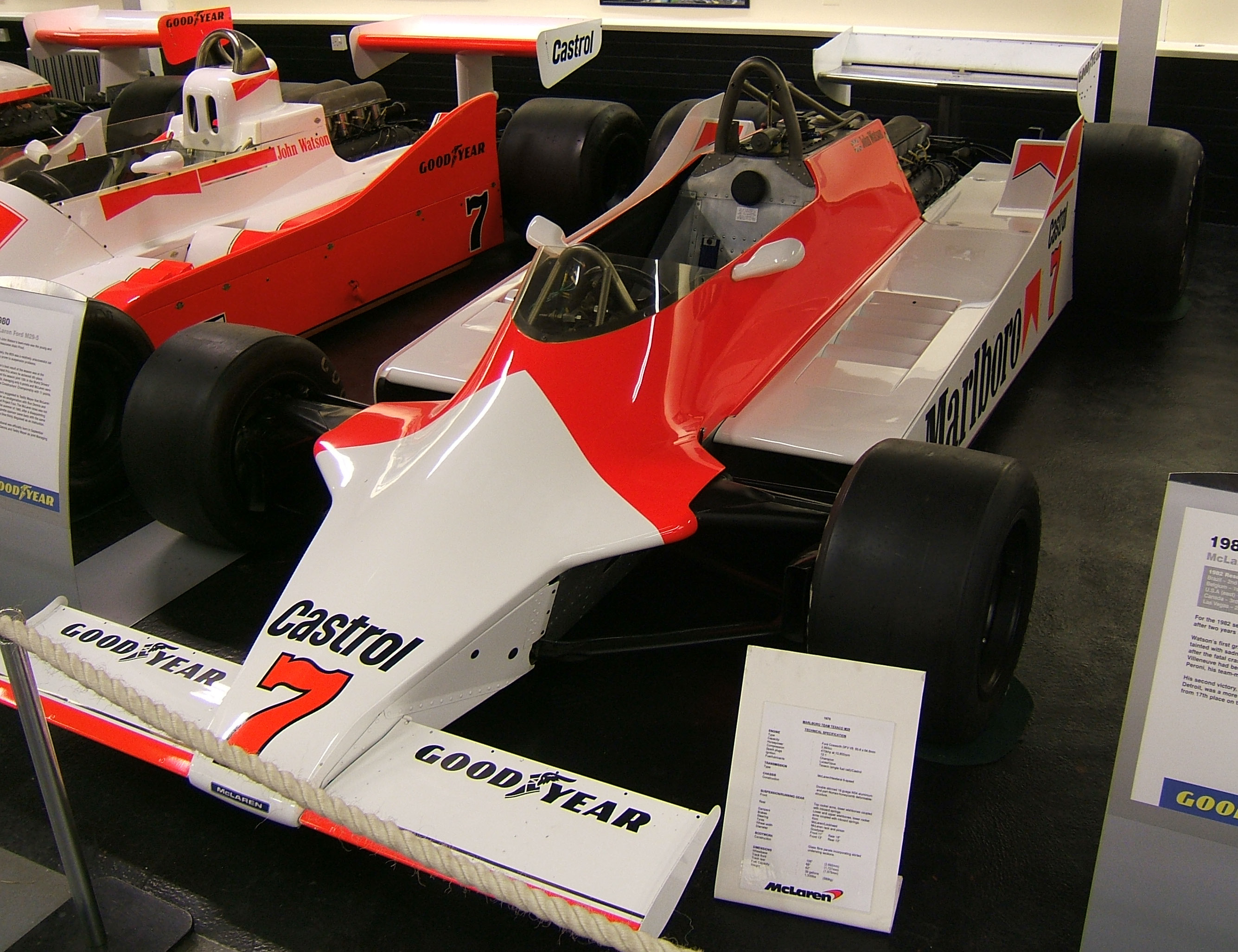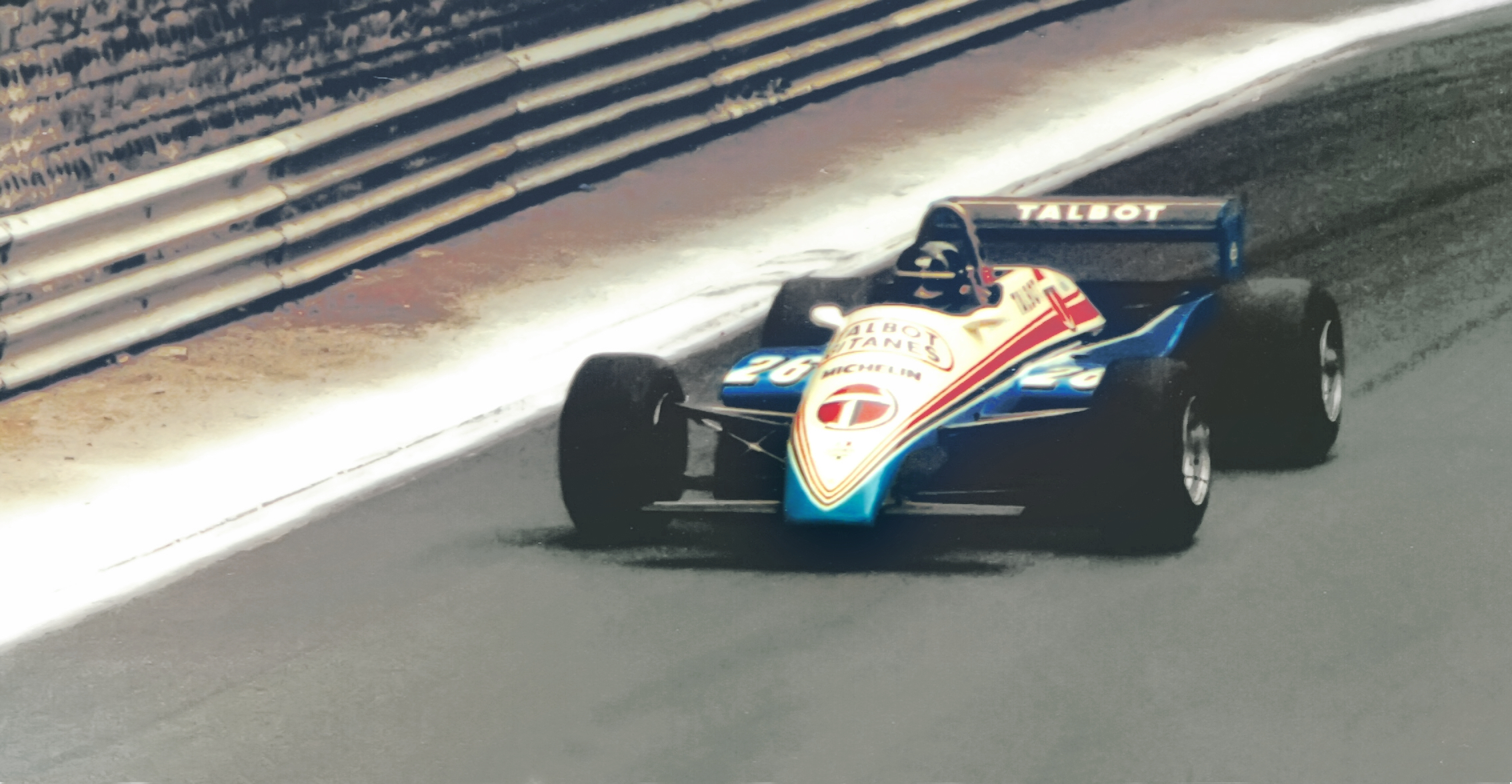|
1980 Brazilian Grand Prix
The 1980 Brazilian Grand Prix was a Formula One motor race held on 27 January 1980 at the Interlagos circuit in the Interlagos neighborhood of São Paulo. It was the second round of the 1980 Formula One season, and it was also the ninth Brazilian Grand Prix. It was the eighth to be held at Interlagos and would be the last until the circuit was substantially redeveloped for the 1990 Brazilian Grand Prix. The race was held over 40 laps of the 7.87-kilometre (4.9 mile) circuit for a total race distance of 315 kilometres. This race was originally supposed to be held at the Jacarepaguá circuit in Rio de Janeiro, but was transferred to Interlagos because parts of the Rio circuit's tarmac were actually sinking into the soft swampland the circuit was built on. This last-minute switch to Interlagos- which was to be resurfaced and heavily rebuilt with new pit facilities and safety measures for the 1981 season caused a lot of controversy- Interlagos had returned a bit too soon for some of t ... [...More Info...] [...Related Items...] OR: [Wikipedia] [Google] [Baidu] |
Brazilian Grand Prix
The Brazilian Grand Prix ( pt, Grande Prêmio do Brasil), currently held under the name São Paulo Grand Prix ( pt, Grande Prêmio de São Paulo), is a Formula One championship race which is currently held at the Autódromo José Carlos Pace in Interlagos neighborhood, Cidade Dutra, São Paulo. Origins Motor racing started in Brazil before World War II, with races on the Gávea street circuit in Rio de Janeiro starting in 1934. In 1936 construction began on Brazil's first permanent autodrome in the São Paulo neighborhood of Interlagos and was finished in 1940. Brazil held Grands Prix during the early parts of WWII at Interlagos and Gavea. Interlagos, a circuit inspired in layout by the Roosevelt Raceway in the United States quickly gained a reputation as being a tough and demanding circuit with many challenging corners, elevation changes, a rough surface, and little room for error. Formula One Interlagos, São Paulo A Brazilian Grand Prix was first held in ... [...More Info...] [...Related Items...] OR: [Wikipedia] [Google] [Baidu] |
Rio De Janeiro
Rio de Janeiro ( , , ; literally 'River of January'), or simply Rio, is the capital of the Rio de Janeiro (state), state of the same name, Brazil's List of Brazilian states by population, third-most populous state, and the List of largest cities in Brazil, second-most populous city in Brazil, after São Paulo. Listed by the Globalization and World Cities Research Network, GaWC as a global city, beta global city, Rio de Janeiro is the Largest cities in the Americas, sixth-most populous city in the Americas. Part of the city has been designated as a World Heritage Site, named "Rio de Janeiro: Carioca Landscapes between the Mountain and the Sea", on 1 July 2012 as a Cultural Landscape. Founded in 1565 by the Portuguese people, Portuguese, the city was initially the seat of the Captaincies of the Portuguese Empire, Captaincy of Rio de Janeiro, a domain of the Portuguese Empire. In 1763, it became the capital of the State of Brazil, a List of states of the Portuguese Empire, state o ... [...More Info...] [...Related Items...] OR: [Wikipedia] [Google] [Baidu] |
Arrows A3
The Arrows A3 was a Formula One car which the Arrows team used to compete in the 1980 and 1981 Events January * January 1 ** Greece enters the European Economic Community, predecessor of the European Union. ** Palau becomes a self-governing territory. * January 10 – Salvadoran Civil War: The FMLN launches its first major off ... Formula One seasons. After the failure of the A2 in the 1979 Formula One season, the A3 was a very conventional design. The A3 featured a short wheelbase and conventional front nose and rear wing. The only aerodynamic novelty was a gearbox enclosure to reduce drag. The car was used in 1981, as Arrows did not have the resources to create a car with hydropneumatic suspension like the Brabham BT49C. Complete Formula One World Championship results ( key) (results in bold indicate pole position) References A03 {{F1-stub ... [...More Info...] [...Related Items...] OR: [Wikipedia] [Google] [Baidu] |
Riccardo Patrese
Riccardo Gabriele Patrese (born 17 April 1954) is an Italian former racing driver, who raced in Formula One from to . He became the first Formula One driver to achieve 200 Grand Prix starts when he appeared at the 1990 British Grand Prix, and then became the first to achieve 250 starts at the 1993 German Grand Prix. For 19 years, he held the record for the most Formula One Grand Prix starts, with 256 races from 257 entries. As of the end of the season he is the ninth-most experienced F1 driver in history. At the age of 38 he was runner-up to Nigel Mansell in the 1992 Formula One World Championship, and third in and . He won six Formula One races, with a record gap of over six years between two of these – the 1983 South African Grand Prix and 1990 San Marino Grand Prix. Patrese also competed at the World Sportscar Championship for the Lancia factory team, finishing runner-up in 1982 and collecting eight wins. Early life and career Born in Padua, Veneto, Patrese sta ... [...More Info...] [...Related Items...] OR: [Wikipedia] [Google] [Baidu] |
McLaren M29
The McLaren M29 is a Formula One racing car built and run by McLaren during the 1979 Formula One World Championship and the 1980 Formula One World Championship. The F version of the McLaren M29 was built in 1979, but only ran during five races of the 1981 Formula One World Championship The 1981 FIA Formula One World Championship was the 35th season of FIA Formula One motor racing. It featured the 1981 Formula One World Championship for Drivers and the 1981 Formula One World Championship for Constructors, which were contest .... The M29F was the last of the M-numbered cars to be raced, as later in the season, the McLaren MP4/1 was readied for use in the championship. Complete Formula One World Championship results ( key) (results in bold indicate pole position) (results in ''italics'' indicate fastest lap) * 8 points in scored using the McLaren M28 ** 1 point in scored using the McLaren M30 *** 27 points in scored using the McLaren MP4/1 McLaren Form ... [...More Info...] [...Related Items...] OR: [Wikipedia] [Google] [Baidu] |
Alain Prost
Alain Marie Pascal Prost (; born 24 February 1955) is a French retired racing driver and Formula One Formula One (also known as Formula 1 or F1) is the highest class of international racing for open-wheel single-seater formula racing cars sanctioned by the Fédération Internationale de l'Automobile (FIA). The World Drivers' Championship ... team owner. A four-time Formula One World Drivers' Champion, from 1987 until 2001 he held the record for most Grand Prix victories until Michael Schumacher surpassed Prost's total of 51 victories at the 2001 Belgian Grand Prix. In 1999, Prost received the World Sports Award of the Century in the motor sport category. Prost discovered Kart racing, karting at the age of 14 during a family holiday. He progressed through motor sport's junior ranks, winning the French and European Formula Three championships, before joining the McLaren Formula One team in 1980 Formula One season, 1980 at the age of 24. He finished in the points on hi ... [...More Info...] [...Related Items...] OR: [Wikipedia] [Google] [Baidu] |
Didier Pironi
Didier Joseph Louis Pironi (26 March 1952 – 23 August 1987) was a French racing driver. During his career, he competed in 72 Formula One World Championship Grands Prix, driving for Tyrrell (1978–1979), Ligier (1980) and Ferrari (1981–1982), his F1 career ending after a practice crash at the 1982 German Grand Prix. He won the 24 Hours of Le Mans in 1978 driving a Renault Alpine A442B. Professional driving career (1972–1982) Pironi was born in Villecresnes, Val-de-Marne. He is the half brother and first cousin of José Dolhem (they had the same father and their mothers were sisters). He began studying as an engineer and earned a degree in science, but entering the family construction business fell by the wayside following his enrollment at the Paul Ricard driving school. He was awarded Pilot Elf sponsorship in 1972, a program designed to promote young French motorsport talent, that also led Alain Prost, René Arnoux and Patrick Tambay into Formula One. After ... [...More Info...] [...Related Items...] OR: [Wikipedia] [Google] [Baidu] |
Jacques Laffite
Jacques-Henri Laffite (; born 21 November 1943) is a French former racing driver who competed in Formula One from to . He achieved six Grand Prix wins, all while driving for the Ligier team. From 1997 to 2013, Laffite was a presenter for TF1. Early years Jacques-Henri Laffite was born in Paris on 21 November 1943. He attended the Cours Hattemer, a private school. Formula One career Laffite debuted in Formula One in 1974 for Frank Williams' Iso–Marlboro team. The following year he raced for the same team, now named Williams, scoring a second place in the German Grand Prix at the Nürburgring. In Laffite moved to the French Ligier team, scoring 20 points and a pole position at the Italian Grand Prix. The next two seasons were transitional, although he managed to win his first Grand Prix at Anderstorp in the 1977 Swedish Grand Prix. The 1979 season opened with Laffite winning the first two races. He fought for the World Championship title until the last races, but e ... [...More Info...] [...Related Items...] OR: [Wikipedia] [Google] [Baidu] |
Ferrari 312T5
The Ferrari 312T was a Ferrari Formula One car design, based on the 312B3 from 1974. In various versions, it was used from 1975 until 1980. It was designed by Mauro Forghieri for the 1975 season, and was an uncomplicated and clean design that responded well to mechanical upgrades. The 312T series won 27 races, four Constructors' and three Drivers' Championships, making it the most successful car design in Formula One history. It was replaced for the 1981 season by the 126 C, Ferrari's first turbocharged F1 car. It was also Ferrari's last naturally-aspirated F1 car until the Ferrari 640 in 1989, after the ban on turbocharged engines. Mechanical configuration The car was powered by the powerful and reliable ''Tipo'' 015 flat-12 engine which gave around 510 bhp. Although it had to carry more fuel, oil and water than the Cosworth DFV-powered cars the power-to-weight ratio of the flat-12 was about the same as the DFV. The "3" stood for the car's engine displacement (3 ... [...More Info...] [...Related Items...] OR: [Wikipedia] [Google] [Baidu] |
Gilles Villeneuve
Joseph Gilles Henri Villeneuve () (January 18, 1950 – May 8, 1982) was a Canadian racing driver, who spent six years in Grand Prix motor racing with Ferrari, winning six races and widespread acclaim for his performances. An enthusiast of cars and fast driving from an early age, Villeneuve started his professional career in snowmobile racing in his native province of Quebec. He moved into single seaters, winning the US and Canadian Formula Atlantic championships in 1976, before being offered a drive in Formula One with the McLaren team at the 1977 British Grand Prix. He was taken on by reigning world champions Ferrari for the end of the season and drove for the Italian team from 1978 until his death in 1982. He won six Grand Prix races in a short career at the highest level. In 1979, he finished second by four points in the championship to teammate Jody Scheckter. Villeneuve died in a crash caused by a collision with the March car driven by Jochen Mass during qualifying f ... [...More Info...] [...Related Items...] OR: [Wikipedia] [Google] [Baidu] |
Ligier JS11/15
The Ligier JS11 was a ground effect Formula One car designed by Gérard Ducarouge. It was powered by the Ford Cosworth DFV married to a Ligier in-house built gearbox. It competed in the and World Championships and proved to be very competitive. Driven by Jacques Laffite, the car won the first two races of the 1979 season and scored consistently.''The Observer'' page 32 Sunday 4 February 1979 The Ligiers stayed in contention throughout the season, with Patrick Depailler winning a further race in Spain. The team eventually finished third behind Ferrari and Williams in the constructors' championship. Depailler was injured halfway through the season in a hang-gliding accident and was replaced by Jacky Ickx, but he struggled to keep pace with the car and his teammate and left at the end of the season, having scored only a handful of points. However, the car soon proved to have problems, starting at the fourth race of the season at Long Beach in the United States. The car was in fa ... [...More Info...] [...Related Items...] OR: [Wikipedia] [Google] [Baidu] |
Williams FW07B
The Williams FW07 was a ground effect Formula One racing car designed by Patrick Head, Frank Dernie, and Neil Oatley for the 1979 F1 season. Design 1979 It was closely based on the Lotus 79, even being developed in the same wind tunnel at Imperial College London. Some observers, among them Lotus aerodynamicist Peter Wright felt the FW07 was little more than a re-engineered Lotus 79, just having a stiffer chassis. The car was small and simple and extremely light, powered by the ubiquitous Ford Cosworth DFV. It had very clean lines and seemed to be a strong challenger for the new season, but early reliability problems halted any serious threat for the title. While not the first to use ground effects in Formula One, an honour belonging to Colin Chapman and the Lotus 78 (the Lotus 79's predecessor), Head may have had a better grasp of the principles than even Chapman. While Head had been developing the Lotus 78's/79's basic principles in the FW07, Chapman’s design tea ... [...More Info...] [...Related Items...] OR: [Wikipedia] [Google] [Baidu] |







.jpg)